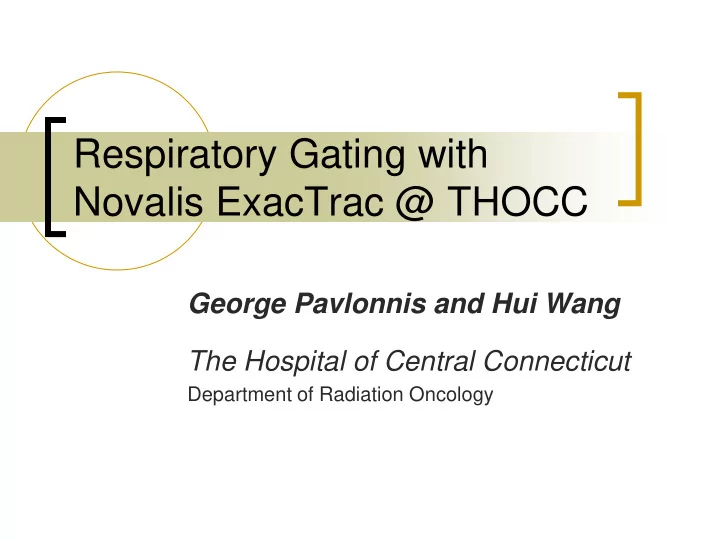

Respiratory Gating with Novalis ExacTrac @ THOCC George Pavlonnis and Hui Wang The Hospital of Central Connecticut Department of Radiation Oncology
Disclosures I don’t know what I am talking about I usually make things up as I go If you believe anything I say during this presentation you should start making your own disclosure statement!
Why Gating ? Target Motion Lung Liver Adrenal glands Beam on when target in position
4D CT Simulation Surrogate motion tracked with IR camera CT slices acquired at different phases of respiratory cycle Move couch and repeat acquisition Sort images by using phase stamp
Motion Assessment Determine extent of target motion Determine treatment window Generate MIP Use treatment window center phase CT for planning.
Treatment Planning Maximize Beam Utilization Minimize Motion (S/I) Lung Motion (2 mm to 18 mm) Liver (10 mm to 28 mm) Renal (5 mm to 24 mm) AP/PA & LT/RT to a much lesser extent Beam Orientation and Couch
Imaging Couch Top (ICT) Couch Dimensions Lack of Skin Sparring Number of Beams Orientation of Beams
Treatment Planning Prescription Doses (Stage I/II NSCLC) Non-centrally located lesions 2,000 cGy/fx x 3 fractions (RTOG 0618) 1,800 cGy/fx x 3 fractions (RTOG 0618 - Hetero) 3,400 cGy (1 Fraction) vs 4,800 cGy (4 Fractions) (RTOG 0915) Centrally located lesions 1,000 cGy/fx x 5 fractions (RTOG 0813)
Treatment Planning Monte Carlo vs. Pencil Beam
Treatment Planning
Treatment Planning
Treatment Planning SRS - 3 Fractions Values from Timmerman are "mostly unvalidated" and based on their SBS/SBRT experience. This table was mostly reproduced from his excellent article Volume Total Dose Dose per Max Point Max Point Dose per Structure Endpoint Notes (cc) (Gy) Fraction (Gy) Dose (Gy) Fraction (Gy) Brachial plexus (ipsilateral) 3 22.5 7.5 24 8.0 Neuropathy Bronchus (ipsilateral) 4 15 5.0 30 10.0 Stenosis/fistula Avoid circumferential radiation Esophagus 5 21 7.0 27 9.0 Stenosis/fistula Avoid circumferential radiation Great vessels 10 39 13.0 45 15.0 Aneurysm Heart/pericardium 15 24 8.0 30 10.0 Pericarditis Liver >700 17.1 5.7 - - Basic liver function Parallel structure, spare at least this volume* Lung (right and left) 15% 20 6.7 - - Minor deviation Lung (right and left) 10% 20 6.7 - - Ideal Lung (right and left) >1000 11.4 3.8 - - Pneumonitis Parallel structure, spare at least this volume* Lung (right and left) >1500 10.5 3.5 - - Basic lung function Parallel structure, spare at least this volume* Sacral plexus 3 22.5 7.5 24 8.0 Neuropathy Skin 10 22.5 7.5 24 8.0 Ulceration Spinal cord 0.25 18 6.0 22 7.3 Myelitis Spinal cord 1.2 11.1 3.7 22 7.3 Myelitis Stomach 10 21 7.0 24 8.0 Ulceration/fistula Trachea 4 15 5.0 30 10.0 Stenosis/fistula Avoid circumferential radiation RTOG 0618 only lists Max Point Doses, so all Volume/Dose points are from Timmerman Timmerman: Robert D. Timmerman, "An Overview of Hypofractionation and Introduction to This Issue of Seminars in Radiation Oncology," Sem Rad Onc 18, 215-222 (2008). *For parallel structures, subtract the volume that receives the listed dose from the total size of the organ and verify it is less than the volume listed. For example, a patient's liver is 2000 cc. An inte receives 17.1 Gy. This means (100%-55%=) 45% of the liver has been spared from 17.1 Gy. 45% of this patient's liver is 900 cc, which is more than the listed 700 cc volume, so the plan would meet that the DVH point you would use for IMRT optimization in this case would be (2000-700)/2000 = 65% volume and 17.1 Gy dose.
Delivery Team Approach RTT’s, Physics & Physician Typical time ~ 30 minutes Challenges Amplitude modulated surrogate Nomenclature
How It’s Done Track surrogate motion with IR cameras
How It’s Done Correlation of internal target motion and external surrogate motion Set target on isocenter at the center of the beam- on time window with robotic couch Determine Beam On Time Snap Imaging
Distribution of Cases 22 Cases Since February 2009 Gallbladder 5% Adrenal Gland 9% Liver 5% Lung 81%
Pros and Cons Pros Reduced Margin Sparing of Healthy Tissue More Accurate Tumor Delivery Cons Longer Treatment Time Potential Pneumothorax from Marker Placement Potential Skin Reaction from 6D Couch Potential Rib Fractures
Recommend
More recommend